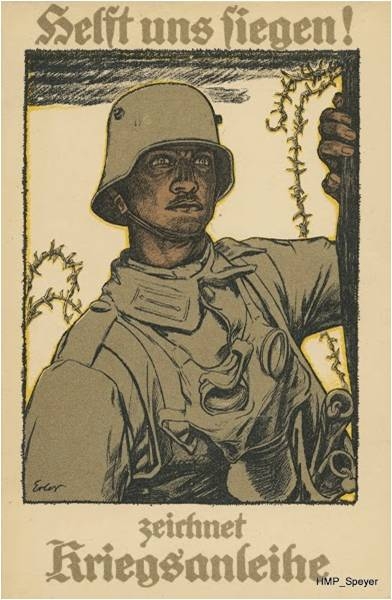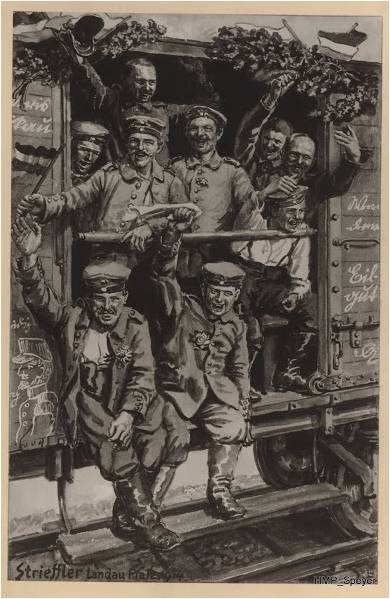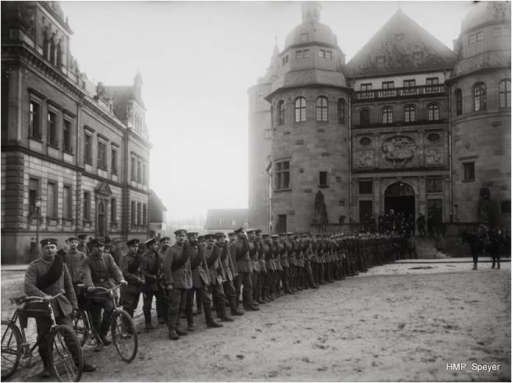Dr. Ludger Tekampe of the Historical Museum of the Palatinate writes for Centenary News about the impact of the First World War in the Palatinate region in Speyer, Germany and regional plans to commemorate the conflict in 2014.
Translated by: Anna Bearfield, Centenary News
In 2014, the centenary of the beginning of the First World War will take place. The Historical Museum of the Palatinate wants to commemorate these events in three ways. The museum will, from June 2014 onwards, present its permanent exhibition about the cconflict in a new light. The museum will present many themes relating to the outbreak of hostilities, which will highlight the experience of the Bavarian Palatinate in the conflict.
From August 1914, supplies and men rolled through the Palatinate towards the front in Lorraine and the Alsace. Civilian railway traffic became restricted as endless troop transporters drove through stations. Heinrich Strieffler (1872-1949) recreated the supposedly “popular” outbreak of the war on postcards which will be exhibited.
Furthermore, the numerous hospital sites in the Palatinate will be examined. From the first weeks of the war, civilian hospitals filled with the wounded. Emergency hospitals had to be established in many parts of the Palatinate region. The Red Cross transported the injured from Strasburg down the Rhine, in order to send wounded soldiers to special clinics in Mannheim and Heidelberg. Palatinate military hospitals could house up to 18000 soldiers.
Prisoners of War
It will not only be the injured, but the interned we aim to commemorate. The great Prisoners of War (POW) camps in Landau and Gemersheim will be of particular focus. In Landau, over 1000 French soldiers were interned at the POW camp. Prisoners were also brought to Landau temporarily from other nearby areas. These prisoners were to be shipped from Landau to Switzerland and through to the south of France. There are manifold photos and documents that remain from the Landau camp. However, the largest POW camp was located in Germersheim. Although Germersheim was only intended to intern up to 4000 prisoners, it held nearly 7000 Russian and 2600 Italian soldiers by 1918.
From 1915, POWs were increasingly sent to work in industry and agriculture. While for this group the supply of food was reasonably well assured, the camp prisoners suffered. Particularly in the last year of the war, prisoners in Gemersheim suffered repeatedly, and died from malnutrition. Since the beginning of the war, the urban civilian population had also become malnourished. In many cities, rationing was introduced. From very early on in the war, compulsory cultivation of basic foodstuffs began. Many staple foods were only acquirable with special warrants, due to the British naval blockade.
From 1916 onwards, hunger riots took place amongst the Palatinate population. Those profiteering on the black market were not exempt from the suffering, and also felt the effects of the food crisis. Even those who owned larger farms and wineries suffered shortages.
Industry
We feel it is important to recognise the expansion of the Palatine defence industry during the conflict. By the end of the war, BASF had moved nearly three-quarters of its production to chemicals that were needed for explosives or gas production. Without this production, which produced large-scale ammonia from 1915 onwards, the German Reich would have had to end the war.

The Reich’s industry was cut off due to the British naval blockade, which eliminated Germany’s ability to import chemicals previously acquired from Chile. Other sectors of industry also had to shift their production towards military equipment – including the metallurgic industry, as well as the wood and textile industries.
The Palatinate aviation factory in Speyer became the Reich’s third largest producer of fighter aircraft. Since most skilled workers were sent out to the front, there was soon a labour shortage in both industry and agriculture. This meant that more women were employed in occupations previously reserved for men.
The ‘War Collection’
The starting point of all these various themes is found in the ‘War Collection’ – a set of archives found at the Historical Museum of the Palatine that had remained relatively untouched until recently. Famous local Palatine historian Albert Becker (1879-1957) was responsible for the creation of the collection. It includes (amongst other things), Palatine war literature, war prints, veterans’ birth and death certificates and war artefacts. Predominantly, posters have been collected from the occupied territories in Belgium and France, as well as war publications, postcards, hand-written songs and poems.

In addition to the renewal of the permanent exhibition, the new data from the ‘War Collection’ will gradually be made available on a publicly accessible database. This is the second aspect of the overall centenary project. The third and last aspect will be to involve citizens further afield from the museum in the commemorative year of 2014.
European funding
The European Union is funding the Historical Museum of the Palatinate within the framework of an INTERREG project with 50% of the total to just under €180,000. This is part of a wider project in the Upper Rhine region, which has received a combined budget of €2.5 million.
One of the agreed objectives of the INTERREG project is the presentation of eight exhibitions in 2014. All of these exhibitions will focus on the First World War (the “seminal catastrophe of the twentieth Century”) and provide an inclusive approach to the French, German and Swiss perspectives of the conflict.
Besides the Speyer museum, museums in Strasburg, Mulhouse, Rastatt, Freiburg, Liestal, Delémont and Lörrach will take part in marking the 100 year anniversary of the conflict. The ‘Three Countries Museum’ in Lörrach will be spearheading the programme.
Images courtesy of the Historical Museum of the Palatine
© Centenary Digital Ltd & Author
